锂离子电池电量检测系统设计(含电路图,程序)
无需注册登录,支付后按照提示操作即可获取该资料.
锂离子电池电量检测系统设计(含电路图,程序)(11000字)
摘 要
锂离子电池与其他种类的电池相比有着诸多优势,已经成为我们日常生活中必不可少的一部分。相信在使用锂离子电池的过程中,我们常会考虑还剩多少电量的问题,但是又找不到好的电量检测方法,针对该要求,本文设计了一种基于单片机的锂离子电池电量检测系统,该检测系统可以满足我们日常生活中对锂离子电池电量检测的需求,以全面掌握锂离子电池的电量状态。
本文主要叙述了基于单片机的锂离子电池电量检测系统的研究和设计,该系统主要由模拟量采集、锂离子电池检测模块、单片机模块、以及LED驱动显示电量等相应的部分组成,介绍了锂离子电池的特点、电池电量检测原理、系统的结构及性能,重点介绍了该系统的软硬件设计等。
考虑到检测系统的复杂程度、精确性、可靠性等各个方面,本文介绍的设计方案能够满足我们对锂离子电池电量检测的要求。
关键字:锂离子电池 BQ2040 电池检测 单片机 LED显示
Abstract
Compared with other types of batteries, the lithium-ion battery have many advantages, becoming an indispensable part of our daily lives. I believe that in the process of using lithium-ion battery, we often consider the question of how much power is left, but they can not find a good power detection method. for the requirements, we design a lithium-ion battery detection system based on MCU, the detection system can meet the demand for lithium-ion battery detection in our daily lives , in order to fully grasp the charge status of the lithium-ion battery.
This paper describes the research and design of lithium-ion battery detection system based on MCU The system consists of a Analog acquisition module, battery detection module, MCU module and LED drive power display modules. the article describes the characteristics of the lithium-ion battery, the battery detection principle, structure and performance of the system,, focusing on the system hardware and software design.
Taking into account the complexity of the detection system, accuracy, reliability, and other aspects, the article describes the design can meet the requirements of our lithium-ion battery detection.
Key words:Lithium-ion battery BQ2040 Battery detection MCU LED display
该系统总体结构可以划分为几个重要部分:锂离子电池模拟量参数采集部分、电量检测部分、中央处理控制部分(单片机)和LED驱动显示部分。每个部分重要器件的选型已经在前面具体说明,将系统总体结构分为以上各部分后,整个系统的工作原理及重要模块等信息便简单明了,系统每个部分都有着其自己重要的责任,只有系统内的每个模块都按其职责正常运行,整个锂离子电池电池检测系统才能正常工作。如图2-1所示,该图为锂离子电池电量检测系统的总体结构框图,其中模拟量参数采集部分负责通过传感器及测量电路等来采集锂离子电池的模拟量参数,这些参数包括锂离子在放电过程中的电流(压)大小、检测到的温度值等相关参数;电量检测部分主要负责依据上部分已经采集到的参数,对锂离子电池的电量进行检测与计算,这两个部分可由BQ2040完成;中央处理控制部分即单片机负责对整个系统进行控制;LED驱动显示部分负责驱动LED,并对被测锂离子电池的剩余电量信息进行数码输出显示。
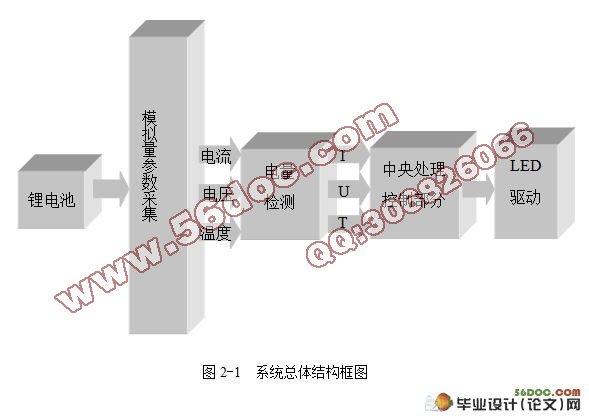
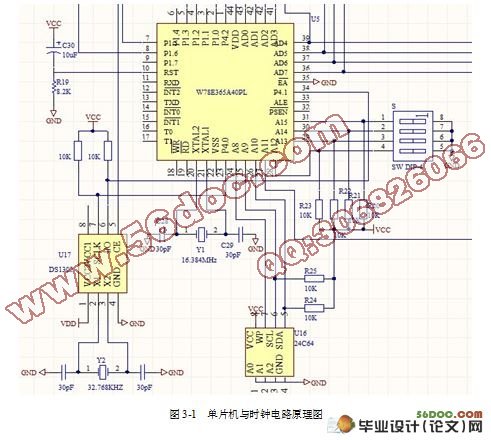
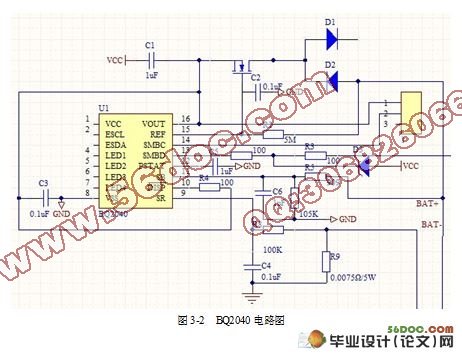
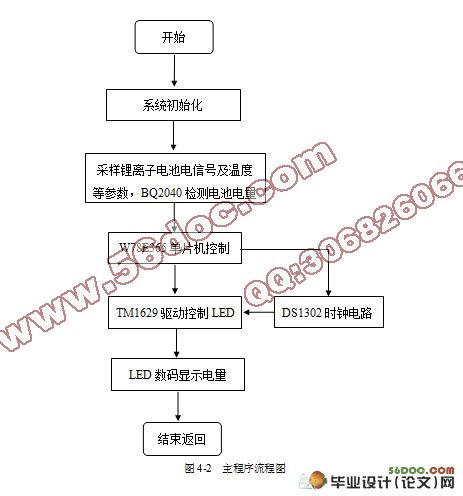
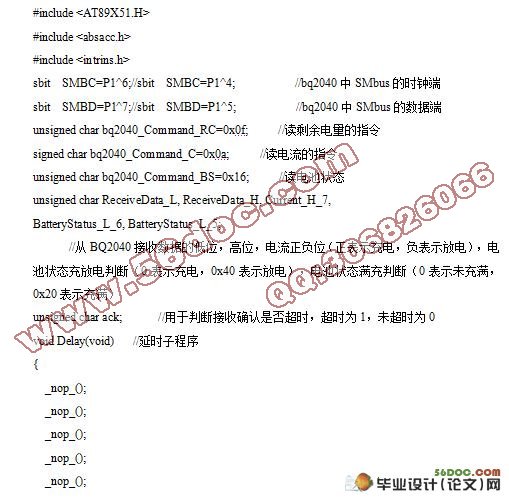
目录
摘 要 I
Abstract II
第一章 绪论 1
1.1 本课题研究的目的及意义 1
1.2 本课题研究内容 1
1.3 锂离子电池的放电及温度特性 2
1.4 锂离子电池电量检测系统的发展方向 3
第二章 系统总体结构设计 4
2.1 系统总体结构框图 4
2.2 单片机的选择 5
2.2.1 W78E365A40PL引脚说明 5
2.2.2 W78E365特性介绍 6
2.3 电池电量检测芯片BQ2040 7
2.3.1 BQ2040 引脚说明 7
2.3.2 BQ2040的检测原理 8
2.4 LED驱动控制芯片TM1629 9
2.4.1 TM1629引脚说明 9
2.4.2 TM1629特性介绍 10
2.5 数据传输存储芯片24C64 11
2.5.1 24C64概述 11
2.5.2 24C64引脚说明 11
2.5.3 24C64特性介绍 12
2.6 时钟芯片DS1302 12
2.6.1 DS1302概述 12
2.6.2 DS1302引脚说明 12
第三章 硬件系统设计 14
3.1 单片机与时钟电路部分 14
3.1.1 W78E365概述 14
3.1.2 电路图设计 14
3.2 BQ2040部分 15
3.2.1 BQ2040概述 15
3.2.2 电路图设计 16
3.3 TM1629驱动控制LED显示部分 16
3.3.1 TM1629概述 16
3.3.2 LED数码管 16
3.3.3 电路图设计 17
第四章 软件系统设计 18
4.1 程序设计流程 18
4.1.1 初始化 18
4.1.2 主程序流程图 19
4.1.3 A/D转换与中断服务 20
4.2 BQ2040总线时序 21
第五章 系统测试 23
结 论 24
参考文献 25
致 谢 26
附 录 27
